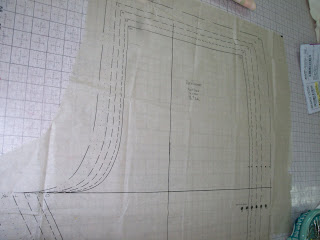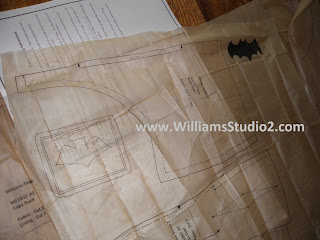Today we start assembling our Pajama pants. You should have your pieces cut out and your ruffles ruffled.
The first step is to mark the wrong side of my fabric so I don't get confused and end up with two right legs or something equally rediculous, two left legs. I identify the wrong side by placing small bits of masking tape to the wrong side of each pant leg.
Now that our pieces are labeled we will sew our inseam using a French Seam. Here we have a nice illustration of how and what a french seam looks like. Its somewhat clearer I hope then the pictures.
 |
| trimming your seam allowance back to 1/8" |
Step 1 - Sewing the inseam
To begin take one back pant leg and one front pant leg and with wrong sides together sew the inseam of your pant leg at 3/8". After sewing trim your seam allowance back to 1/8".
Press to set the stitch into the fabric. Open and press the seam allowance to one side.
Now fold the seam along your stitch line placing the right sides of your fabric together and stitch again this time at 1/4".
Repeat this for the other pant leg.
Step 2 - Marking Ruffle placement.
Fold your hem up to the wrong side 1/2" and press. Fold again along your hem line (mine was 4") to the wrong side and press again.
Lay your pant leg on a table with right side facing you and the pressed hem layed out flat so that you can see the hem fold you just pressed.
Draw a line parallel to your hem line 1" up from the crease.
Draw 2 more lines 1-1/4" each above the first line.
You can use a pencil or dissapearing ink marker, whichever shows up the best on your fabric.
This marks the placements lines for our ruffles to go on.
Step 3 - Sewing Side Seam
 |
| side seam with wrong sides together and ruffle placement marked ready for its french seam. |
Using your french seam technique again sew your side seams on both pant legs. You now have two pant legs ready to be hemmed and ruffled.
Step 4 - Hemming
 |
| Hemming from inside the pant leg. Pin you hem in place. Turn your pant legs right side out. Edge stitch your hem, by sewing from inside the pant leg as pictured. To edge stitch you will stitch right next to your top fold all around your hem. You do not need to back stich because as you come around to complete the hem you can sew a few stitches over from where you started. Step 5 - Sew your ruffles into loops. Take one of your 6 ruffled strips and french seam the short ends together to for a loop. You may need to remove a tuck or two on each end to accomplish this neatly. Repeat for all ruffled strips. Step 6 - Sew your ruffles to your pant legs If you have a free arm sewing the ruffles on is a good opportunity to use it. If you do not have a free arm, sew from inside the pant leg, as you did the hem. Pin your ruffle loop down the center to the 1st line (nearest your hem) and stitch down the center. If your loop is a longer the your pant leg just add a tuck into your ruffle. If your loop is short take a tuck out by removing some stitches. Repeat with 2 more ruffles moving up the pant leg each time. Once all three ruffles are on one leg, repeat the process for the other. Step 7 - Sew your crotch seam. Now that you have two ruffled pant legs. Take one pant leg and turn it inside out, so that you have one leg right side out, and one inside out. Insert the right side out pant leg into the inside out pant leg and line up your inseams. Pin around your crotch and stitch. Next finish your seam by trimming back to 1/4" and zig zagging or serging or using the overlock stitch on your machine if it has one. You can check your manual to see. back crotch curve is deep front crotch curve is shallow You should now have pajama pants, not just pajama pant legs. Congratulations! Next week we will finish them by smocking our waistband. Previous pajama pantaloon posts: The Pantaloon Plan Lets Begin Cutting Strips for Ruffles Sewing Ruffles |













































